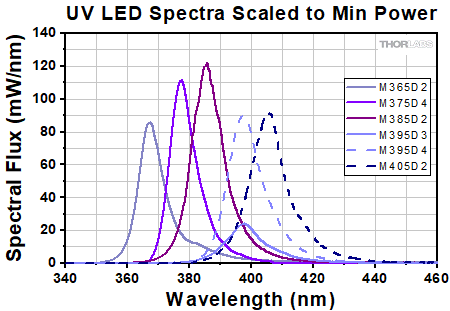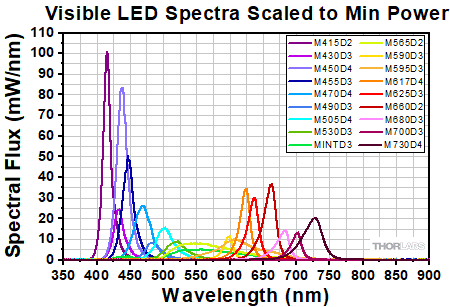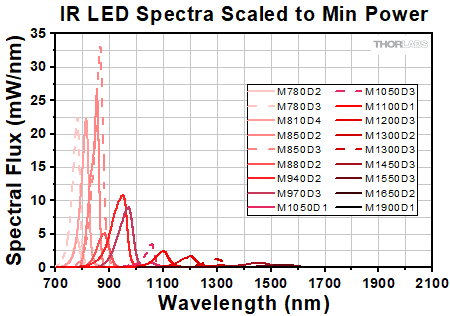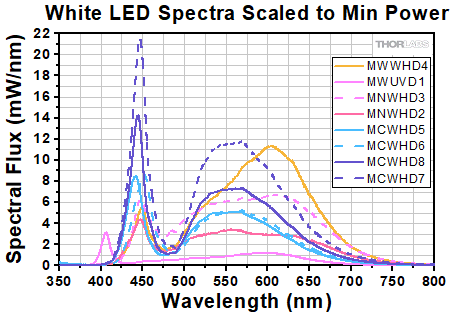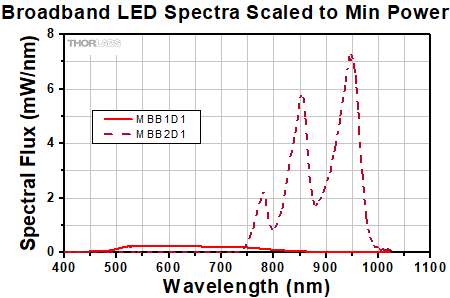
LEDs on Metal-Core PCBs
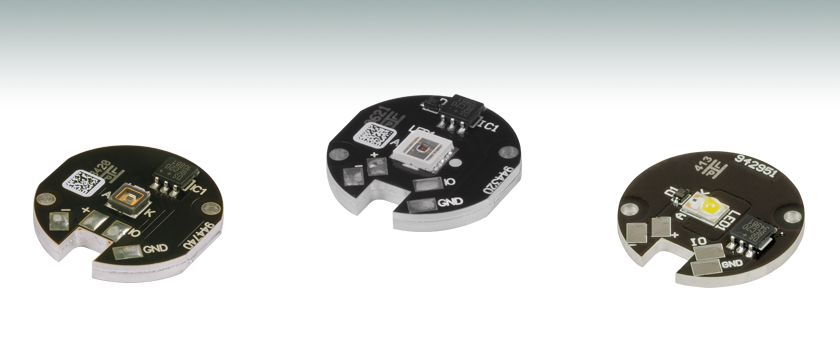
- UV, Visible, IR, and Mid-IR Models Available
- LED Mounted on Metal-Core Printed Circuit Board
- Ideal for OEM Applications
M340D4
340 nm LED,
≥45.5 mW Power Output
M1300D3
1300 nm LED,
≥122.8 mW Power Output
M565D2
565 nm LED,
≥880 mW Power Output
OVERVIEW
Features
- Nominal Wavelengths Ranging from 233 nm to 5200 nm
- White, Dual-Peak, and Broadband LEDs Also Available
- Minimum Outputs Ranging from 0.8 mW to 2118.1 mW
- LED Mounted on Metal-Core Printed Circuit Board for Excellent Heat Management
- Long Lifetimes (See Tables G1.1 through G9.1 for Details)
Thorlabs' LEDs on Metal-Core Printed Circuit Boards (MCPCBs) are designed to provide high-power output in a compact package. Each LED package consists of a single LED that has been soldered to an MCPCB. These LEDs are ideal for OEM or custom applications; they should not be used for household illumination.
Thorlabs uses high-thermal-conductivity MCPCB materials. The MCPCB is designed to provide good thermal management. However, the LED must still be mounted onto an appropriate heat sink using thermal paste to ensure proper operation and to maximize operating lifetime. Mounting holes are provided on the MCPCB surface for attaching the LED to a heat sink; the Ø2 mm through holes are compatible with #1 (M2) screws (not included).
The spectrum of each LED and complete specifications can be viewed by clicking on the info icon (![]() ) for each LED linked in Tables G1.1 through G9.1 for details. Multiple windows can be opened simultaneously in order to compare LEDs.
) for each LED linked in Tables G1.1 through G9.1 for details. Multiple windows can be opened simultaneously in order to compare LEDs.
Thorlabs also offers mounted LEDs with an integrated heat sink, as well as collimated mounted LEDs, which are compatible with microscopes from major manufacturers. For fiber applications, we also offer fiber-coupled LEDs. For questions on choosing an appropriate LED and to discuss mounting requirements, please contact Tech Support.
Optimized Thermal Management
These LEDs possess good thermal stability properties; hence, degradation of the optical output power due to increased LED temperature is not an issue when the LED is properly mounted to a heat sink using thermal paste, thermal epoxy, or thermally conductive double-sided tape.
White Light, Dual-Peak, and Broadband LEDs
Our warm, neutral, and cold white LEDs feature broad spectra that span several hundred nanometers. The difference in appearance amongst these three LEDs can be described using the correlated color temperature, which indicates that the LEDs color appearance is similar to a black body radiator at that temperature. In general, warm white LEDs offer a spectrum similar to a tungsten source, while cold white LEDs have a stronger blue component to the spectrum; neutral white LEDs provide a more even illumination spectrum over the visible range than warm white or cold white LEDs. Cold white LEDs are more suited for fluorescence microscopy applications or cameras with white balancing, because of a higher intensity at most wavelengths compared to warm white LEDs. Neutral white LEDs are ideal for horticultural applications.
For horticultural applications requiring illumination in both red and blue portions of the spectrum, Thorlabs offers the MPRP1D2. This purple LED features dual peaks at 455 nm and 640 nm, respectively, to stimulate photosynthesis (see graph to compare the absorption peaks of photosynthesis pigments with the LED spectrum). The LED was designed to maintain the red/blue ratio of the emission spectrum over its lifetime to provide high uniformity of plant growth.
The MBB1D1 broadband LED has a relatively flat spectral emission over a wide wavelength range. Its FWHM bandwidth ranges from 500 nm to 780 nm, while its 10 dB bandwidth ranges between 470 nm and 940 nm. The MBB2D1 broadband LED features a spectrum with peaks at approximately 770 nm, 860 nm, and 940 nm.
Soldering
These LEDs have been soldered to a metal core with low thermal resistance. While this feature allows for good thermal management, it can also prevent the metal pads from reaching the appropriate temperature for soldering when the package is connected to a heat sink. To properly solder wires to the pads, first make sure that the metal core is not in contact with a heat sink or a metal surface. We recommend using a small vise or similar device to hold the MCPCB during the soldering process and wires with a minimum gauge of 24 AWG (0.25 mm2).
To solder wires to the MCPCB, first hold the copper bit of the soldering iron on one of the pads for approximately 30 seconds using a soldering temperature of about 350 °C. The soldering iron will heat the entire metal-core PCB, so do not touch the LED package until it has cooled down after the soldering process. Test the temperature by touching tin solder to the pad: the solder will melt and flow evenly over the entire pad at the correct temperature. Coat the other pads with tin solder. Now, solder the wires to the pads. Use tweezers or pliers to remove the MCPCB from the vise and place it on a heat sink or metal surface. The metal-core PCB will cool down in several seconds and is now ready for your application.
For convenient connection of the LEDs to the drivers listed on the LED Drivers tab, please order the optional CAB-LEDD1 LED connection cable below.
Driver Options and Pin Assignments
Thorlabs offers six drivers compatible with some or all of these LEDs: LEDD1B, UPLED, DC40, DC2200, DC4100, and DC4104 (the latter two require the DC4100-HUB). See the LED Drivers tab for compatibility information and a list of specifications. The UPLED, DC40, DC2200, DC4100, and DC4104 drivers are capable of reading the current limit from the EEPROM chip of the connected LED and automatically adjusting the maximum current setting to protect the LED.
To connect the PCB to a driver, please note that the soldering pad labeled "+" is the Anode (+V), and the pad labeled "-" is the Cathode. These LEDs can be operated without connecting EEPROM IO and EEPROM GND, but both must be connected in order for the driver to read the current limit. The soldering pads on different items may be in different locations, but the labels are the same.
Collimation
These LEDs have large viewing angles, so for many applications it is beneficial to collimate the beam. See the Collimation tab for information on collimating the light from an LED.
RELATIVE POWER
Relative Power
The actual spectral output and total output power of any given LED will vary due to variations in the manufacturing process and operating parameters, such as temperature and current. Both a typical and minimum output power are specified to help you select
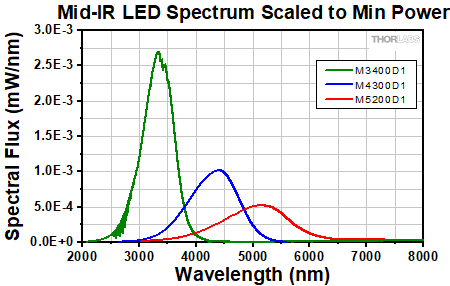
Click to Enlarge
Click Here for Data
The spectrum shown for M4300D1 and M5200D1 are ideal.
Please see their Spec Sheets for more information.
STABILITY

Click to Enlarge
Figure 3.1 Graph of Optical Output Power
LED Lifetime and Long-Term Power Stability
One characteristic of LEDs is that they naturally exhibit power degradation with time. Often this power degradation is slow, but there are also instances where large, rapid drops in power, or even complete LED failure, occur. LED lifetimes are defined as the time it takes a specified percentage of a type of LED to fall below some power level. The parameters for the lifetime measurement can be written using the notation BXX/LYY, where XX is the percentage of that type of LED that will provide less than YY percent of the specified output power after the lifetime has elapsed. Thorlabs defines the lifetime of our LEDs as B50/L50, meaning that 50% of the LEDs with a given Item # will fall below 50% of the initial optical power at the end of the specified lifetime. For example, if a batch of 100 LEDs is rated for 150 mW of output power, 50 of these LEDs can be expected to produce an output power of ≤75 mW after the specified LED lifetime has elapsed.
Optimizing Thermal Management
In order to achieve stable optical output power and maximize lifetime from your LED, the MCPCB must be properly mounted to a heat sink using thermally conductive paste in order to minimize the degradation of optical output power caused by increased LED junction temperature (see Figure 3.1).
LED DRIVERS
To fully support the max optical power of the LED you intend to drive, ensure that the max voltage and max current of the driver are equal to or greater than those of the LED.
| Compatible Drivers | LEDD1B | UPLEDa | DC40a | DC2200a | DC4100a,b | DC4104a,b |
|---|---|---|---|---|---|---|
| Click Photos to Enlarge |  |
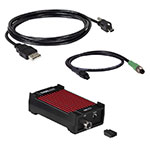 |
 |
 |
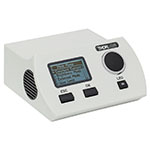 |
 |
| LED Driver Current Output (Max)c | 1.2 A | 1.2 A | 4.0 Ad | LED1 Terminal: 10.0 A LED2 Terminal: 2.0 Ae |
1.0 A per Channel | 1.0 A per Channel |
| LED Driver Forward Voltage (Max)f | 12 V | 8 V | 14.0 Vd | 50 V | 5 V | 5 V |
| Modulation Frequency Using External Input (Max) | 5 kHzg | - | 5 kHzg | 250 kHzg,h | 100 kHzg (Simultaneous Across all Channels) |
100 kHzg (Independently Controlled Channels) |
| External Control Interface(s) | Analog (BNC) | USB 2.0 | USB 2.0, TTL, and Analog (BNC) | USB 2.0 and Analog (BNC) | USB 2.0 and Analog (BNC) | USB 2.0 and Analog (8-Pin) |
| Main Driver Features | Very Compact Footprint 60 mm x 73 mm x 104 mm (W x H x D) |
USB-Controlled | Driver Current Up to 4.0 A, Manual and USB-Controlled |
Touchscreen Interface with Internal and External Options for Pulsed and Modulated LED Operation | 4 Channelsb | 4 Channelsb |
| EEPROM Compatible: Reads Out LED Data for LED Settings | - | |||||
| LCD Display | - | - | - |
COLLIMATION
Video Insight: Collimate Light from an LED
Collimating light from an LED or other large, incoherent source can be a surprisingly challenging task. The emitter’s size and the collimating lens’ focal length and numerical aperture (NA) all influence the characteristics of the collimated beam. It can also be hard to know when the lens is positioned optimally. In this video, two lenses with different NAs and focal lengths are used to demonstrate a couple of collimation approaches. In addition, the emerging image of the emitter and other typical features of beams provided by collimating lenses are explored.
RAY DATA 
Ray data for Zemax is available for some of the bare LEDs incorporated into these high-powered light sources. This data is provided in a zipped folder that can be downloaded by clicking on the red document icons (![]() ) next to the part numbers in the pricing tables below. Every zipped folder contains an information file and one or more ray files for use with Zemax:
) next to the part numbers in the pricing tables below. Every zipped folder contains an information file and one or more ray files for use with Zemax:
- Information File: This document contains a summary of the types of data files included in the zipped folder and some basic information about their use. It includes a table listing each document type and the corresponding filenames.
- Ray Files: These are binary files containing ray data for use with Zemax.
For the LEDs marked with an superscript "a" in Table 6.1, the following additional pieces of information are also included in the zipped folder:
- Radiometric Color Spectrum: This .spc file is also intended for use with Zemax.
- CAD Files: A file indicating the geometry of the bare LED. For the dimensions of the high-power mounted LEDs that include the package, please see the support drawings provided by Thorlabs.
- Sample Zemax File: A sample file containing the recommended settings and placement of the ray files and bare LED CAD model when used with Zemax.
Table 6.1 summarizes the ray files available for each LED and any other supporting documentation provided.
LED SELECTION GUIDE
This tab includes all LEDs sold by Thorlabs. Click on More [+] to view all available wavelengths for each type of LED pictured below.
| Light Emitting Diode (LED) Selection Guide | |||||
|---|---|---|---|---|---|
| Click Photo to Enlarge (Representative; Not to Scale) |
 |
 |
 |
 |
 |
| Type | Unmounted LEDs | Pigtailed LEDs | LED Arrays | LED Ring Light | Cage-Compatible Diffuse Backlight LED |
| Light Emitting Diode (LED) Selection Guide | ||||||
|---|---|---|---|---|---|---|
| Click Photo to Enlarge (Representative; Not to Scale) |
 |
 |
 |
 |
 |
 |
| Type | PCB- Mounted LEDs |
Heatsink- Mounted LEDs |
Collimated LEDs for Microscopyb | Fiber- Coupled LEDsc |
High-Power LEDs for Microscopy | Multi-Wavelength LED Source Optionsd |
Deep UV LEDs (233 - 340 nm)
Please note that our deep UV LEDs radiate intense UV light during operation. Precautions must be taken to prevent looking directly at the UV light, and UV light protective glasses must be worn to avoid eye damage. Exposure of the skin and other body parts to UV light should be avoided.
Part Number | Description | Price | Availability |
|---|---|---|---|
M233D1 | NEW! 233 nm, 0.6 mW (Min) LED on Metal-Core PCB, 100 mA | $1,071.18 | In Stock Overseas |
M265D4 | 265 nm, 38.4 mW (Min) LED on Metal-Core PCB, 440 mA | $391.51 | Today |
M275D2 | 275 nm, 45 mW (Min) LED on Metal-Core PCB, 700 mA | $280.38 | Today |
M275D3 | 275 nm, 47.3 mW (Min) LED on Metal-Core PCB, 300 mA | $164.06 | Lead Time |
M280D4 | 280 nm, 78 mW (Min) LED on Metal-Core PCB, 500 mA | $298.02 | Today |
M300D3 | 300 nm, 26 mW (Min) LED on Metal-Core PCB, 350 mA | $429.61 | In Stock Overseas |
M310D1 | 308 nm, 38.5 mW (Min) LED on Metal-Core PCB, 600 mA | $529.99 | Lead Time |
M325D3 | 325 nm, 25 mW (Min) LED on Metal-Core PCB, 600 mA | $569.70 | In Stock Overseas |
M340D4 | 340 nm, 45.5 mW (Min) LED on Metal-Core PCB, 600 mA | $331.08 | Today |
UV LEDs (365 - 405 nm)
Please note that our UV LEDs radiate intense UV light during operation. Precautions must be taken to prevent looking directly at the UV light, and UV light protective glasses must be worn to avoid eye damage. Exposure of the skin and other body parts to UV light should be avoided.
Part Number | Description | Price | Availability |
|---|---|---|---|
M365D2 | 365 nm, 1150 mW (Min) LED on Metal-Core PCB, 1700 mA | $237.69 | Today |
M375D4 | 375 nm, 1270 mW (Min) LED on Metal-Core PCB, 1400 mA | $68.54 | Today |
M385D2 | 385 nm, 1650 mW (Min) LED on Metal-Core PCB, 1700 mA | $237.69 | Today |
M395D3 | 395 nm, 400 mW (Min) LED on Metal-Core PCB, 500 mA | $160.17 | Lead Time |
M395D4 | 395 nm, 1420 mW (Min) LED on Metal-Core PCB, 1400 mA | $237.69 | In Stock Overseas |
M405D2 | 405 nm, 1500 mW (Min) LED on Metal-Core PCB, 1400 mA | $237.69 | Today |
Single-Color Cold Visible LEDs (415 - 565 nm)
Please note that the 415 nm (violet), 430 nm (violet), and 450 nm (royal blue) LEDs radiate intense UV light during operation. Precautions must be taken to prevent looking directly at the UV light, and UV light protective glasses must be worn to avoid eye damage. Exposure of the skin and other body parts to the UV light should be avoided.
Part Number | Description | Price | Availability |
|---|---|---|---|
M415D2 | 415 nm, 1640 mW (Min) LED on Metal-Core PCB, 2000 mA | $87.24 | Today |
M430D3 | 430 nm, 529.2 mW (Min) LED on Metal-Core PCB, 500 mA | $97.63 | Today |
M450D4 | 450 nm, 2118.1 mW (Min) LED on Metal-Core PCB, 2000 mA | $72.57 | Today |
M455D3 | 455 nm, 1150 mW (Min) LED on Metal-Core PCB, 1000 mA | $61.88 | In Stock Overseas |
M470D4 | 470 nm, 809 mW (Min) LED on Metal-Core PCB, 1000 mA | $75.63 | In Stock Overseas |
M490D3 | 490 nm, 205 mW (Min) LED on Metal-Core PCB, 350 mA | $90.89 | Today |
M505D4 | 508 nm, 550 mW (Min) LED on Metal-Core PCB, 1200 mA | $98.83 | Today |
M530D3 | 530 nm, 370 mW (Min) LED on Metal-Core PCB, 1000 mA | $87.08 | Today |
MINTD3 | 554 nm, 650 mW (Min) LED on Metal-Core PCB, 1225 mA | $145.18 | Today |
M565D2 | 565 nm, 880 mW (Min) LED on Metal-Core PCB, 1000 mA | $73.72 | Today |
Single-Color Warm Visible LEDs (590 - 727 nm)
Part Number | Description | Price | Availability |
|---|---|---|---|
M590D3 | 590 nm, 230 mW (Min) LED on Metal-Core PCB, 1000 mA | $79.84 | Today |
M595D3 | 595 nm, 820 mW (Min) LED on Metal-Core PCB, 1500 mA | $99.85 | Today |
M617D4 | 617 nm, 737.4 mW (Min) LED on Metal-Core PCB, 1000 mA | $74.89 | Today |
M625D3 | 625 nm, 700 mW (Min) LED on Metal-Core PCB, 1000 mA | $84.69 | Today |
M660D2 | 660 nm, 940 mW (Min) LED on Metal-Core PCB, 1200 mA | $81.97 | In Stock Overseas |
M680D3 | NEW! 680 nm, 380 mW (Min) LED on Metal-Core PCB, 600 mA | $139.67 | Today |
M700D3 | NEW! 700 nm, 290 mW (Min) LED on Metal-Core PCB, 500 mA | $98.40 | Today |
M730D4 | 727 nm, 780 mW (Min) LED on Metal-Core PCB, 1000 mA | $99.53 | Today |
IR LEDs (780 - 1900 nm)
Part Number | Description | Price | Availability |
|---|---|---|---|
M780D2 | 780 nm, 200 mW (Min) LED on Metal-Core PCB, 800 mA | $73.72 | Today |
M780D3 | 780 nm, 800 mW (Min) LED on Metal-Core PCB, 800 mA | $132.19 | Today |
M810D4 | 810 nm, 810 mW (Min) LED on Metal-Core PCB, 1000 mA | $129.63 | In Stock Overseas |
M850D2 | 850 nm, 900 mW (Min) LED on Metal-Core PCB, 1200 mA | $73.72 | In Stock Overseas |
M850D3 | 850 nm, 1400 mW (Min) LED on Metal-Core PCB, 1500 mA | $143.64 | Today |
M880D2 | 880 nm, 300 mW (Min) LED on Metal-Core PCB, 1000 mA | $73.72 | Today |
M940D2 | 940 nm, 800 mW (Min) LED on Metal-Core PCB, 1000 mA | $73.72 | In Stock Overseas |
M970D3 | 970 nm, 600 mW (Min) LED on Metal-Core PCB, 1000 mA | $93.46 | In Stock Overseas |
M1050D1 | 1050 nm, 50 mW (Min) LED on Metal-Core PCB, 700 mA | $87.08 | In Stock Overseas |
M1050D3 | 1050 nm, 160 mW (Min) LED on Metal-Core PCB, 600 mA | $208.10 | Today |
M1100D1 | 1100 nm, 168 mW (Min) LED on Metal-Core PCB, 1000 mA | $227.87 | Today |
M1200D3 | 1200 nm, 136 mW (Min) LED on Metal-Core PCB, 1000 mA | $177.03 | Today |
M1300D2 | Customer Inspired! 1300 nm, 25 mW (Min) LED on Metal-Core PCB, 500 mA | $135.19 | Today |
M1300D3 | 1300 nm, 122.8 mW (Min) LED on Metal-Core PCB, 1000 mA | $180.94 | Today |
M1450D3 | 1450 nm, 81.8 mW (Min) LED on Metal-Core PCB, 1000 mA | $174.61 | Today |
M1550D3 | 1550 nm, 46 mW (Min) LED on Metal-Core PCB, 1000 mA | $191.37 | In Stock Overseas |
M1650D2 | 1650 nm, 13 mW (Min) LED on Metal-Core PCB, 600 mA | $224.30 | Today |
M1900D1 | 1900 nm, 10 mW (Min) LED on Metal-Core PCB, 1000 mA | $240.15 | Today |
Mid-IR LEDs (3400 - 5200 nm)
Part Number | Description | Price | Availability |
|---|---|---|---|
M3400D1 | 3400 nm, 2.2 mW (Min) LED on Metal-Core PCB, 200 mA | $1,265.01 | In Stock Overseas |
M4300D1 | 4300 nm, 1.1 mW (Min) LED on Metal-Core PCB, 200 mA | $1,265.01 | Lead Time |
M5200D1 | 5200 nm, 0.8 mW (Min) LED on Metal-Core PCB, 200 mA | $1,240.22 | Today |
Purple LED (455 nm / 640 nm)
Our dual-peak LED was designed for applications requiring illumination in both red and blue portions of the spectrum, such as horticulture. This purple LED features dual peaks at 455 nm and 640 nm, respectively, to stimulate photosynthesis (see graph to compare the absorption peaks of photosynthesis pigments with the LED spectrum). The LED was designed to maintain the red/blue ratio of the emission spectrum over its lifetime to provide high uniformity of plant growth.
Part Number | Description | Price | Availability |
|---|---|---|---|
MPRP1D2 | 455 nm (12.5%) / 640 nm, 275 mW (Min) LED on Metal-Core PCB, 300 mA | $51.10 | Lead Time |
White LEDs (400 - 700 nm Wavelength Range)
Our warm, neutral, and cold white LEDs feature broad spectra that span several hundred nanometers. The difference in appearance among these LEDs can be described using the correlated color temperature, which indicates that the LEDs color appearance is similar to a black body radiator at that temperature. In general, warm white LEDs offer a spectrum similar to a tungsten source, while cold white LEDs have a stronger blue component to the spectrum; neutral white LEDs provide a more even illumination spectrum over the visible range than warm white or cold white LEDs. Cold white LEDs are more suited for fluorescence microscopy applications or cameras with white balancing, because of a higher intensity at most wavelengths compared to warm white LEDs. Neutral white LEDs are ideal for horticultural applications.
Part Number | Description | Price | Availability |
|---|---|---|---|
MWWHD4 | 3000 K, 1713 mW (Min) LED on Metal-Core PCB, 700 mA | $87.96 | In Stock Overseas |
MWUVD1 | 4000 K, 235 mW (Min) LED on Metal-Core PCB, 125 mA | $64.17 | Today |
MNWHD3 | 4000 K, 1400 mW (Min) LED on Metal-Core PCB, 2500 mA | $82.13 | In Stock Overseas |
MNWHD2 | 4900 K, 740 mW (Min) LED on Metal-Core PCB, 1225 mA | $56.08 | Today |
MCWHD5 | 6500 K, 930 mW (Min) LED on Metal-Core PCB, 1300 mA | $74.64 | Today |
MCWHD6 | 6500 K, 942 mW (Min) LED on Metal-Core PCB, 1300 mA | $73.11 | Today |
MCWHD8 | 6500 K, 1300.9 mW (Min) LED on Metal-Core PCB, 2000 mA | $79.04 | Today |
MCWHD7 | 6500 K, 2064.8 mW (Min) LED on Metal-Core PCB, 700 mA | $92.20 | Today |
Broadband LEDs
The MBB1D1 broadband LED has a relatively flat spectral emission over a wide wavelength range. Its 10 dB bandwidth ranges between 470 nm and 850 nm. The MBB2D1 broadband LED features a spectrum with peaks at approximately 770 nm, 860 nm, and 940 nm.
Part Number | Description | Price | Availability |
|---|---|---|---|
MBB1D1 | 470 - 850 nm Broadband LED, 70 mW (Min) on Metal-Core PCB, 500 mA | $475.38 | Today |
MBB2D1 | IR Broadband LED (770 nm, 860 nm & 940 nm), 740 mW (Min) on Metal-Core PCB, 1000 mA | $526.65 | In Stock Overseas |
LED Connection Cable

 Figure 10.1 Male M8x1 Connector |
Pin | Description | Wire Color |
|---|---|---|---|
| 1 | LED Anode | Brown | |
| 2 | LED Cathode | White | |
| 3 | EEPROM GND | Black | |
| 4 | EEPROM IO | Blue |
- 4-Pin M8 Connector on One Side
- 4 Bare Wires on Other Side
- 2 m Long, 24 AWG Wires
The 4-Pin M8 connection cable can be used to connect the LEDs on metal-core PCBs to the following Thorlabs LED drivers: LEDD1B, DC40, DC2200, DC4100, and DC4104 (the latter two require the DC4100-HUB).
Pin Connections
Figure 10.1 shows the male connector for use with the above Thorlabs LED drivers. The connector is a standard M8x1 sensor circular connector. Pins 1 and 2 are the connection to the LED. Please note that the bare PCB board LEDs shown on this page do not include an EEPROM like our mounted LEDs; hence pins 3 and 4 should not be connected. Also, note that the pin connection diagram shown here may not be valid for third-party LED drivers.
For customers using their own power supplies, we also offer a female 4-pin M8 connector cable (item # CON8ML-4).
Part Number | Description | Price | Availability |
|---|---|---|---|
CAB-LEDD1 | LED Connection Cable, 2 m, M8 Connector, 4 Wires | $20.21 | Today |


